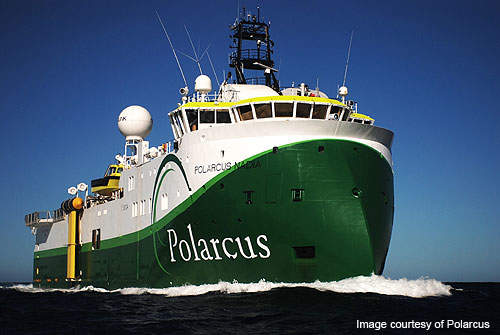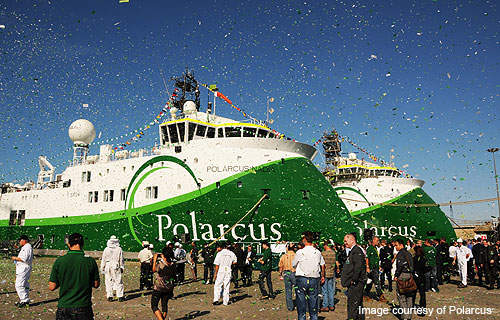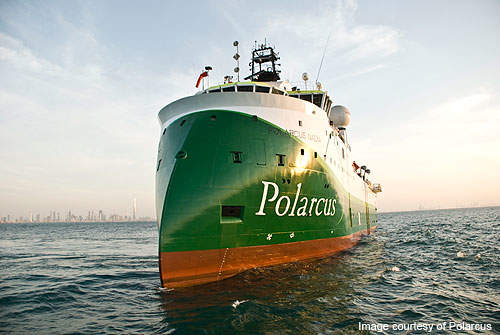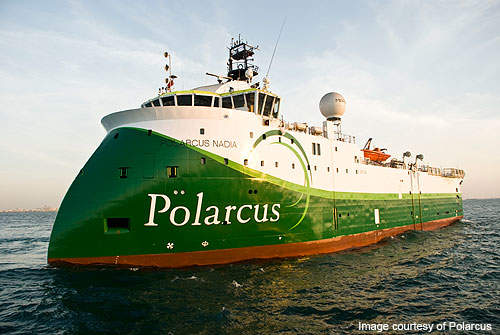The Polarcus Nadia is a modern 12 streamer 3D seismic vessel built at the Dubai shipyard, Drydocks World, a Dubai-based global ship building and repair company. Built for the Dubai-based marine geophysical company Polarcus, it is the most advanced seismic vessel developed at the yard to date, capable of towing up to 12 streamers. It is the first vessel within Polarcus’ fleet that has been custom-built for the high-end 3D marine seismic market.
The vessel was named Nadia, meaning the beginning or first in November 2009. Delivery took place within a month, in December 2009. Polarcus Nadia began operations in January 2010 with its first project in Liberia, West Africa. It commenced a charter for TGS-NOPEC Geophysical Company ASA (TGS) as part of a seismic charter agreement signed on 10 December 2009.
The survey was carried out with a ten-streamer seismic array, each measuring 7,200m in length and separated by 100m. The inaugural five month project was completed in May 2010, after which the vessel transited for further operations to the UK sector of the North Sea.
Operations at the UK sector were completed on 13 November 2010. Polarcus Nadia thereafter transited to the Falkland Islands, where it began production on 26 November 2010.
Design
The vessel has been built to the ULSTEIN SX124 design, including ULSTEIN IAS, ULSTEIN COM IP, ULSTEIN NAV and ULSTEIN PMS packages.
The innovative ship design includes an 88.8m double hull where the inner skin has no oil contact with the outer skin. Compared to conventional hulls, the ULSTEIN X-BOW hull ensures low angles of entry and increased waterline length, offering higher speed in calm waters.
The ship is one of the most environmentally friendly seismic vessels. As bow flare is absent, the bow impact or slamming in foreship is eliminated. Vibration and noise level are reduced as the hull facilitates soft entries in waves. In the accommodation area, the hull is extended to full beam which provides superior protection to the working deck and deck equipment.
The beam of Polarcus Nadia measures 19m. Maximum draught is 6.6m while the gross tonnage is 6,570t. The ship has been designed with a maximum bollard pull of 100t. Accommodation includes 69 berths with 23 single cabins. A Sikorsky S-61N / S-92 helideck is also available on board.
The double hull design is incorporated with several sophisticated safety features including a DP2 dynamic positioning system, advanced bilge water cleaning, and a selective catalytic reduction system that minimises emissions.
The ship is fitted with a 3D seismic system and 12 8,000m Sentinel solid streamers that can be towed at 75m separation.
The streamers can be configured as 12 x 8,000m, 10×10 800m or 8 x 12,000m. To achieve positioning accuracy for the entire array of towed streamers, ION DigiBIRD depth controllers, DigiRANGE acoustics and DigiFIN lateral controllers have been installed.
The seismic energy source consists of Bolt 1500-LL / 1900-LLXT dual sources. Three LMF compressors have been installed. Seismic data is acquired through a Sercel Seal Marine Data Acquisition system. A Seamap GunLink 4000 fully distributed digital gun controller provides in-water firing control and sensor timing monitoring.
Propulsion
The ship is powered by a diesel electric propulsion system, which includes six Wartsila 9L20 engines rated 1,800kW at 1,000rpm each. The maximum speed of the ship is 14kts. Main propulsion is provided by two SCHOTTEL propellers of type SRP 3030 CP rated 3,100kW.
Navigation and communications
The ship’s navigation systems include an ECDIS chart system and DGPS. Navigation equipment includes S-band ARPA radar that ensures target detection in adverse weather conditions and the X-band ARPA radar.
Communication systems installed at the ship include GMDSS communication system, Inmarsat F Fleet-77 satellite communication system and VSAT.












